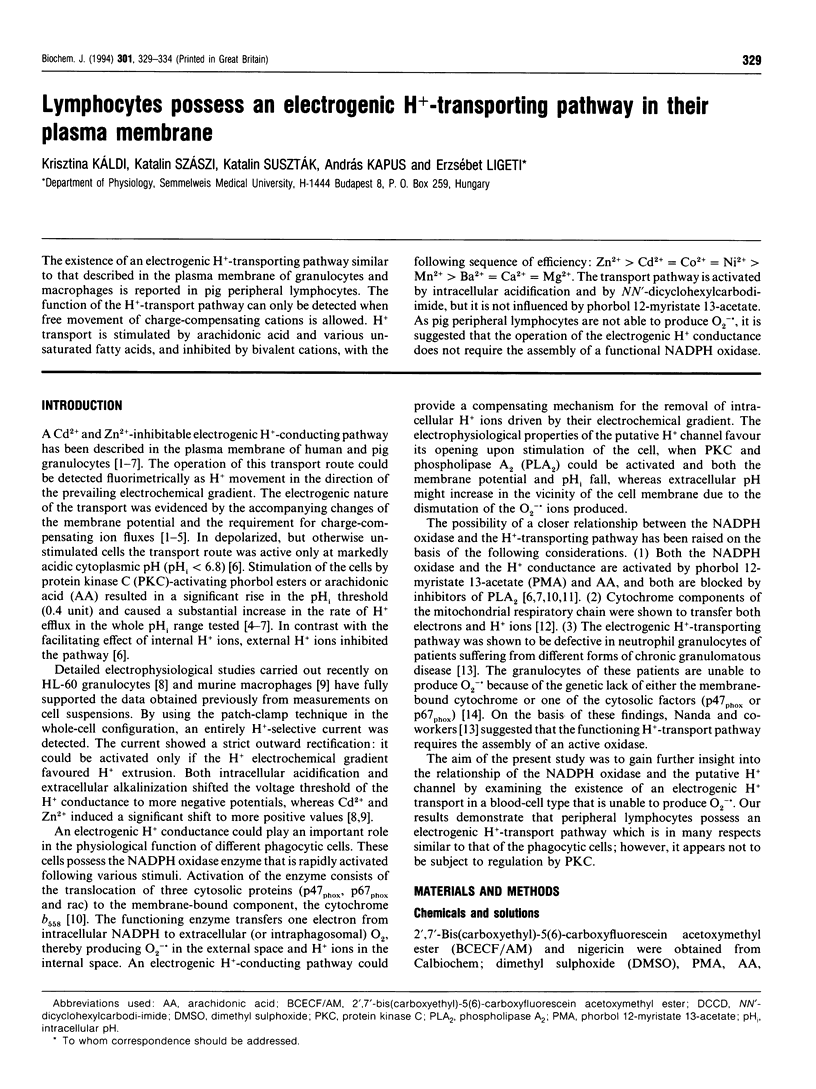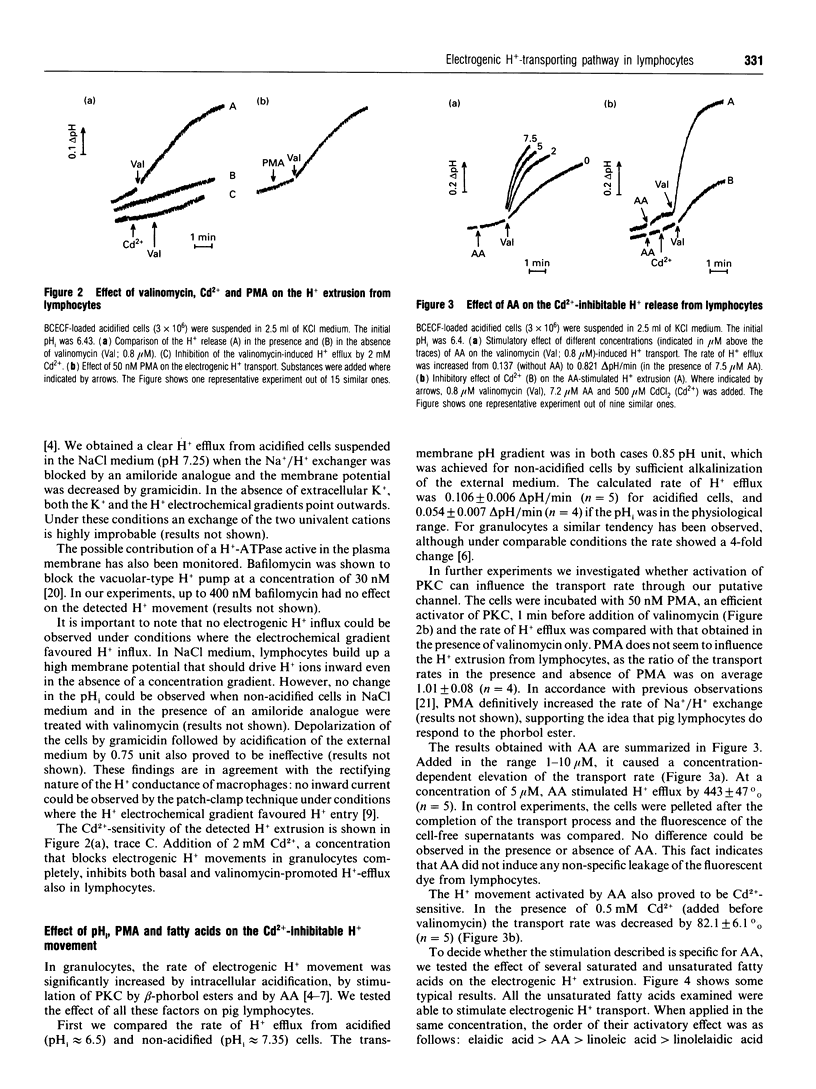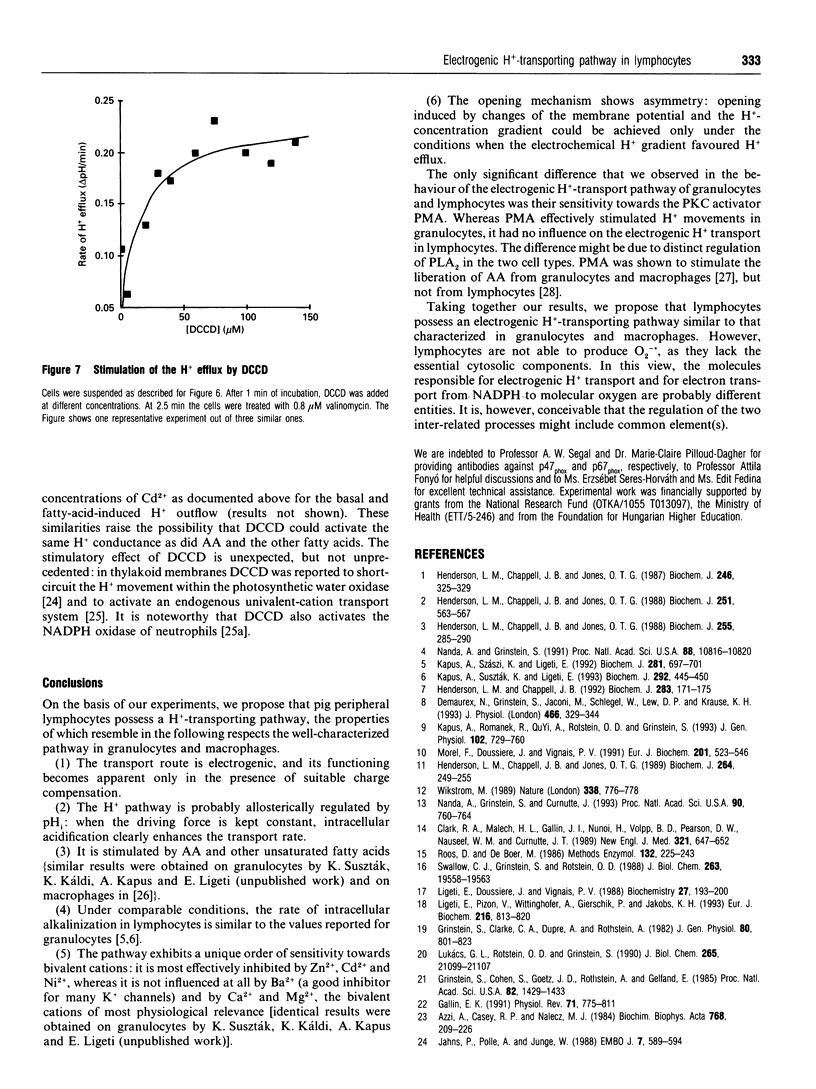Abstract
The existence of an electrogenic H(+)-transporting pathway similar to that described in the plasma membrane of granulocytes and macrophages is reported in pig peripheral lymphocytes. The function of the H(+)-transport pathway can only be detected when free movement of charge-compensating cations is allowed. H+ transport is stimulated by arachidonic acid and various unsaturated fatty acids, and inhibited by bivalent cations, with the following sequence of efficiency: Zn2+ > Cd2+ = Co2+ = Ni2+ > Mn2+ > Ba2+ = Ca2+ = Mg2+. The transport pathway is activated by intracellular acidification and by NN'-dicyclohexylcarbodiimide, but it is not influenced by phorbol 12-myristate 13-acetate. As pig peripheral lymphocytes are not able to produce O2-., it is suggested that the operation of the electrogenic H+ conductance does not require the assembly of a functional NADPH oxidase.
Full text
PDF





Images in this article
Selected References
These references are in PubMed. This may not be the complete list of references from this article.
- Aviram A., Aviram I. Activation of the respiratory burst of guinea pig neutrophils by dicyclohexylcarbodiimide. FEBS Lett. 1983 May 8;155(2):205–208. doi: 10.1016/0014-5793(82)80603-0. [DOI] [PubMed] [Google Scholar]
- Azzi A., Casey R. P., Nałecz M. J. The effect of N,N'-dicyclohexylcarbodiimide on enzymes of bioenergetic relevance. Biochim Biophys Acta. 1984 Dec 17;768(3-4):209–226. doi: 10.1016/0304-4173(84)90017-x. [DOI] [PubMed] [Google Scholar]
- Clark R. A., Malech H. L., Gallin J. I., Nunoi H., Volpp B. D., Pearson D. W., Nauseef W. M., Curnutte J. T. Genetic variants of chronic granulomatous disease: prevalence of deficiencies of two cytosolic components of the NADPH oxidase system. N Engl J Med. 1989 Sep 7;321(10):647–652. doi: 10.1056/NEJM198909073211005. [DOI] [PubMed] [Google Scholar]
- Demaurex N., Grinstein S., Jaconi M., Schlegel W., Lew D. P., Krause K. H. Proton currents in human granulocytes: regulation by membrane potential and intracellular pH. J Physiol. 1993 Jul;466:329–344. [PMC free article] [PubMed] [Google Scholar]
- Gallin E. K. Ion channels in leukocytes. Physiol Rev. 1991 Jul;71(3):775–811. doi: 10.1152/physrev.1991.71.3.775. [DOI] [PubMed] [Google Scholar]
- Grinstein S., Clarke C. A., Dupre A., Rothstein A. Volume-induced increase of anion permeability in human lymphocytes. J Gen Physiol. 1982 Dec;80(6):801–823. doi: 10.1085/jgp.80.6.801. [DOI] [PMC free article] [PubMed] [Google Scholar]
- Grinstein S., Cohen S., Goetz J. D., Rothstein A., Gelfand E. W. Characterization of the activation of Na+/H+ exchange in lymphocytes by phorbol esters: change in cytoplasmic pH dependence of the antiport. Proc Natl Acad Sci U S A. 1985 Mar;82(5):1429–1433. doi: 10.1073/pnas.82.5.1429. [DOI] [PMC free article] [PubMed] [Google Scholar]
- Henderson L. M., Chappell J. B., Jones O. T. Internal pH changes associated with the activity of NADPH oxidase of human neutrophils. Further evidence for the presence of an H+ conducting channel. Biochem J. 1988 Apr 15;251(2):563–567. doi: 10.1042/bj2510563. [DOI] [PMC free article] [PubMed] [Google Scholar]
- Henderson L. M., Chappell J. B., Jones O. T. Superoxide generation by the electrogenic NADPH oxidase of human neutrophils is limited by the movement of a compensating charge. Biochem J. 1988 Oct 1;255(1):285–290. [PMC free article] [PubMed] [Google Scholar]
- Henderson L. M., Chappell J. B., Jones O. T. Superoxide generation is inhibited by phospholipase A2 inhibitors. Role for phospholipase A2 in the activation of the NADPH oxidase. Biochem J. 1989 Nov 15;264(1):249–255. doi: 10.1042/bj2640249. [DOI] [PMC free article] [PubMed] [Google Scholar]
- Henderson L. M., Chappell J. B., Jones O. T. The superoxide-generating NADPH oxidase of human neutrophils is electrogenic and associated with an H+ channel. Biochem J. 1987 Sep 1;246(2):325–329. doi: 10.1042/bj2460325. [DOI] [PMC free article] [PubMed] [Google Scholar]
- Henderson L. M., Chappell J. B. The NADPH-oxidase-associated H+ channel is opened by arachidonate. Biochem J. 1992 Apr 1;283(Pt 1):171–175. doi: 10.1042/bj2830171. [DOI] [PMC free article] [PubMed] [Google Scholar]
- Jahns P., Polle A., Junge W. The photosynthetic water oxidase: its proton pumping activity is short-circuited within the protein by DCCD. EMBO J. 1988 Mar;7(3):589–594. doi: 10.1002/j.1460-2075.1988.tb02851.x. [DOI] [PMC free article] [PubMed] [Google Scholar]
- Kapus A., Romanek R., Qu A. Y., Rotstein O. D., Grinstein S. A pH-sensitive and voltage-dependent proton conductance in the plasma membrane of macrophages. J Gen Physiol. 1993 Oct;102(4):729–760. doi: 10.1085/jgp.102.4.729. [DOI] [PMC free article] [PubMed] [Google Scholar]
- Kapus A., Suszták K., Ligeti E. Regulation of the electrogenic H+ channel in the plasma membrane of neutrophils: possible role of phospholipase A2, internal and external protons. Biochem J. 1993 Jun 1;292(Pt 2):445–450. doi: 10.1042/bj2920445. [DOI] [PMC free article] [PubMed] [Google Scholar]
- Kapus A., Szászi K., Ligeti E. Phorbol 12-myristate 13-acetate activates an electrogenic H(+)-conducting pathway in the membrane of neutrophils. Biochem J. 1992 Feb 1;281(Pt 3):697–701. doi: 10.1042/bj2810697. [DOI] [PMC free article] [PubMed] [Google Scholar]
- Le Gouvello S., Colard O., Theodorou I., Bismuth G., Tarantino N., Debre P. CD2 triggering stimulates a phospholipase A2 activity beside the phospholipase C pathway in human T lymphocytes. J Immunol. 1990 Mar 15;144(6):2359–2364. [PubMed] [Google Scholar]
- Ligeti E., Doussiere J., Vignais P. V. Activation of the O2(.-)-generating oxidase in plasma membrane from bovine polymorphonuclear neutrophils by arachidonic acid, a cytosolic factor of protein nature, and nonhydrolyzable analogues of GTP. Biochemistry. 1988 Jan 12;27(1):193–200. doi: 10.1021/bi00401a029. [DOI] [PubMed] [Google Scholar]
- Ligeti E., Pizon V., Wittinghofer A., Gierschik P., Jakobs K. H. GTPase activity of small GTP-binding proteins in HL-60 membranes is stimulated by arachidonic acid. Eur J Biochem. 1993 Sep 15;216(3):813–820. doi: 10.1111/j.1432-1033.1993.tb18202.x. [DOI] [PubMed] [Google Scholar]
- Lukacs G. L., Rotstein O. D., Grinstein S. Phagosomal acidification is mediated by a vacuolar-type H(+)-ATPase in murine macrophages. J Biol Chem. 1990 Dec 5;265(34):21099–21107. [PubMed] [Google Scholar]
- Morel F., Doussiere J., Vignais P. V. The superoxide-generating oxidase of phagocytic cells. Physiological, molecular and pathological aspects. Eur J Biochem. 1991 Nov 1;201(3):523–546. doi: 10.1111/j.1432-1033.1991.tb16312.x. [DOI] [PubMed] [Google Scholar]
- Nanda A., Grinstein S., Curnutte J. T. Abnormal activation of H+ conductance in NADPH oxidase-defective neutrophils. Proc Natl Acad Sci U S A. 1993 Jan 15;90(2):760–764. doi: 10.1073/pnas.90.2.760. [DOI] [PMC free article] [PubMed] [Google Scholar]
- Nanda A., Grinstein S. Protein kinase C activates an H+ (equivalent) conductance in the plasma membrane of human neutrophils. Proc Natl Acad Sci U S A. 1991 Dec 1;88(23):10816–10820. doi: 10.1073/pnas.88.23.10816. [DOI] [PMC free article] [PubMed] [Google Scholar]
- Opanasenko V. K., Red'ko T. P., Gubanova O. N., Yaguzhinsky L. S. Induction of an electrogenic transfer of monovalent cations (K+, NH4+) in thylakoid membranes by N,N'-dicyclohexylcarbodiimide. FEBS Lett. 1992 Aug 3;307(3):280–282. doi: 10.1016/0014-5793(92)80695-d. [DOI] [PubMed] [Google Scholar]
- Roos D., de Boer M. Purification and cryopreservation of phagocytes from human blood. Methods Enzymol. 1986;132:225–243. doi: 10.1016/s0076-6879(86)32010-x. [DOI] [PubMed] [Google Scholar]
- Swallow C. J., Grinstein S., Rotstein O. D. Cytoplasmic pH regulation in macrophages by an ATP-dependent and N,N'-dicyclohexylcarbodiimide-sensitive mechanism. Possible involvement of a plasma membrane proton pump. J Biol Chem. 1988 Dec 25;263(36):19558–19563. [PubMed] [Google Scholar]
- Volpi M., Molski T. F., Naccache P. H., Feinstein M. B., Sha'afi R. I. Phorbol 12-myristate, 13-acetate potentiates the action of the calcium ionophore in stimulating arachidonic acid release and production of phosphatidic acid in rabbit neutrophils. Biochem Biophys Res Commun. 1985 Apr 30;128(2):594–600. doi: 10.1016/0006-291x(85)90087-7. [DOI] [PubMed] [Google Scholar]
- Wikström M. Identification of the electron transfers in cytochrome oxidase that are coupled to proton-pumping. Nature. 1989 Apr 27;338(6218):776–778. doi: 10.1038/338776a0. [DOI] [PubMed] [Google Scholar]



